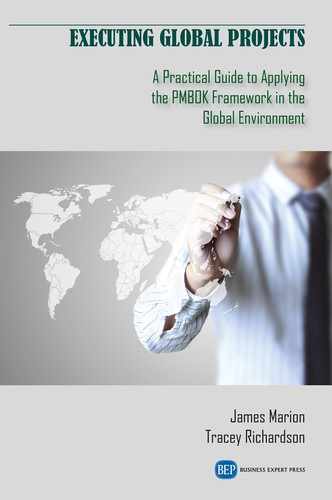Alphabets ‘f’ and ‘t’ after page numbers indicate figure and table, respectively.
authority budget, 77
Balanced Scorecard, the, 125, 126f
Big Mac Index, the, 103–104
application of, 104–105
Change Control Board (CCB), 47
continuous improvement
importance in manufacturing, 45
in product development cycle, 45–46
Corruption Perception Index, 113
cultural dimensions, 56
Hofstede’s, 61f
application, 62f
individualism, 58
long-term orientation, 60
masculinity, 59
power distance, 57–58
restraint vs. indulgence,
60–61, 75
uncertainty avoidance, 60
Trompenaars, 67f
achievement vs. ascription, 65
application, 68f
individualism vs. collectivism, 63
inner vs. outer directed, 66–67
neutral vs. affective, 63–65
sequential vs. synchronic, 66
specific vs. diffuse, 65–66
universalism vs. particularism, 63
culture, 28, 37, 53, 79, 119, 127. See also continuous improvement; ethics
communication behavior mirroring, 93–94
context and processes, 42–43
cultural dimensions
Hofstede’s, 57, 62f
Trompenaars, 57, 68f
culture shock, 83–84
family relocation issues, 85–86
geographical implications on, 55–56
and geography, 53–54
Globe Studies, 72
low context, 38–39
low vs. high context, 39–40, 56, 89, 94
norms standardization, 28
religion and food, 81
role of context in, 37, 40–41
role of food in, 79–81
World Values Survey, 68–69
culture shock, 83–84
customs, 37, 109
ethics
Corruption Perception Index, 113–114
vs. legal framework, 115–116
local vs. universal approach to, 114
ontological vs. deontological approaches, 111–113, 112f
and profit making, 116
social responsibility, 117
spectrum of behavior, 111, 117
sustainability, 117
Foreign Corrupt Practices Act, 111
Global Alliance of Project Management Professionals (GAPP), 15
global process capability, 16, 141
governance, 145
process improvement, 143, 144f, 145
scores, 141f
strategy processes, 7–8
Global Project Factor Management Knowledge Area, 127
global project management, 3. See also ethics; project finances; Project Management Body of Knowledge; project manager
art of negotiation, 94–95
barriers in, 3
communication issues, 87–92
continuous improvement, 45–46
environments in 4f
executing processes, 21, 22t
global risks, 5f
plan elements, 8–10
plan repository, 18f
project scorecard, 125
scenario planning, 10, 11f
strategy implementation, 12
strategy processes, 7–8
strategy selection, 11–12
SWOT analysis in, 6
technical vs. business domain, 49
global risk register, 4, 5f
global risks, 4, 5f, 8. See also ethics
logistics, 109
quantitative approaches in, 12
scenario planning, 10, 11f
unique risks, 13
Globe Studies, 72–73, 76
dimensions of, 72, 72f
uniqueness of, 72
International Project Management Association, 16
Japan, 54, 55, 59
letter of credit (LC), 101
Macroenvironment, components in, 3
Mintzberg standardization, 26–29, 29f
negotiation, 94–95, 117, 119
commercial terms, 106, 107f, 108
cross-cultural, 97
goals of, 95–96
and project closure, 119, 120
settings, 98–99
PRINCE2, 16
process improvement, 50
methods for, 50–51
project closure
aim in, 119, 120f
client acceptance issues, 119
contract closure, 120–121
financial obligations in, 120–121
resource release in, 120
project communication
art of negotiation, 94–95
choice of language, 87–89
communication mirroring, 93–94
connectivity issues, 90
negotiation goals, 95–96
role of non-verbal communication, 91–92
use of commercial terms, 106, 107f, 108
project finances. See also ethics; project closure
commercial terms, use of, 106, 107f, 108
letter of credit (LC), 101
logistics and delivery issues, 108–109
purchase price parity (PPP), 103–104
role of Chief Financial Officer in, 101, 102
taxation issues, 102–103
project management. See also ethics; global project management; project finances
art of negotiation, 94–95
barriers in, 3
communication issues, 87–92
continuous improvement, 45–46
environments in, 4f
project scorecard, 125
technical vs. business domain, 49
Project Management Body of Knowledge (PMBOK), 5, 11, 50, 109, 145. See also ethics
executing processes in, 21, 22t
global plan elements, 8–10
vs. international standards, 15–16, 17f
knowledge areas in, 7t, 8, 12, 13t
Mintzberg standardization, 26–29
project planning repository, 18f, 19
scenario planning, 10, 11f
strategy development, 6
strategy implementation, 12
SWOT analysis in, 6
project manager, 3, 47, 48, 80. See also ethics; project closure; project finances
application of project tools, 51
art of negotiation, 94–95
Change Control Board (CCB), 47–48
communication issues, 87–89
culture shock, 83–84
decision-making elements, 49
distance management for trust, 26–29, 49
food choices, 79–80
goals of negotiation, 95–96
holiday schedules, 82–83
importance of intranet for, 24
norms standardization, 28
output standardization, 28–29, 42
overtime issues, 75–76
personal safety, 15, 113
project change, 46
project risks, 5f
pull vs. push leadership, 77
risks unique to, 13–14
role of non-verbal communication, 91–92
time-lag issues for, 21, 22–23
trust issues for, 24–26, 29
use of authority budget, 76–77
work process standardization, 27
project planning, 16–18
plan executing processes, 21, 22t
plan repository, 18f
project scorecard, global, 123,
127f, 129
aim of, 125
client feedback, 130–131
elements of, 125, 126–127
importance of assessing, 129
project documentation in, 129–130
stakeholder feedback, 131–132
track record for, 129
use of surveys in, 132
project standardization
norms standardization, 28
output standardization, 28–29
work process standardization, 27
projects, global. See also ethics; project finances; Project Management Body of Knowledge; project manager
art of negotiation, 94–95
communication issues, 87–92
complexity in, 3
decision making, local vs. global, 48–49
environment in, 4f
executing processes in, 21, 22t
logistics and delivery issues, 108–109
macroenvironment in, 3
management standards, 17f
plan elements, 8–10
plan repository, 18f
process capability improvement, 143–145
project tools, 51
risks, 5f
role of context in, 37
scenario planning, 10, 11f
scope creep, 47
scorecard, 125, 126f
standardization techniques, 26–29
strategy implementation, 12
strategy selection, 11–12
SWOT analysis in, 6
technical vs. business domain, 49
value chain, 34, 34f
purchase price parity (PPP), 103
application of, 104–105
scope creep, 47
strategic management, project 8.
See also Project Management Body of Knowledge
global plan elements, 8–10
scenario planning, 10, 11f
strategy formulation, 10
strategy implementation, 12
strategy selection, 11–12
Transparency International, 113
United States, 53, 54, 58, 111
value chain, 31–32, 32f
elements of, 31
global vs. local, 33f, 34f
importance in project management, 31
location of elements of, 33–34, 35
World Values Survey, 68, 69f
application, 69
